|


|
Daily excursions:
Rome, Amalfi, Sorrento, Tuscany, Assisi |
|
|
|
Tour of Rome |
Two days tour of Tuscany and Umbria: Siena, San Gimignano,
Pisa, Assisi
|
Amalfi and Sorrento | Assisi
Roman Castles: tour A, B, C, D and Grand Tour
The daily
excursions are prepared only for the clients of Roman Homes,
renting fine vacation rentals. Please do not inquire if your
are not a Roman Homes client.
|
|
|
|
►
Pompeii, Herculanum: presentation.
►
Daily excursion, prices.
Pompeii
was a resort
town inhabited by wealthy Romans who were known
for lavish spending on their homes. The fertile,
volcanic slopes of Vesuvius provided an ideal
climate for grapes and olive groves. Since the
mountain had last erupted long before anyone
alive at the time had been born, people thought
that living near the most recognizable landmark
looming over the bay of Naples was completely
safe. The town had imposing temples, a beautiful
forum, perfectly built theater and stadium.
It was lunch time in August 79 AD when Vesuvius
began 19 hours of spectacular eruptions. |
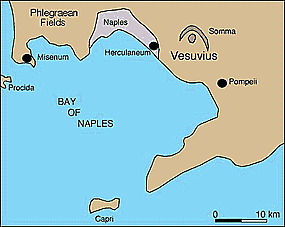 |
|
All the people in the
700 year-old town of 20,000 could have escaped.
There was time to flee. But no one recognized
the inherent danger of the mountain’s warnings. By
the time Vesuvius stopped belching poisonous
gas, the bustling city of Pompeii was silent,
completely buried by volcanic ash and debris. It
remained silent for 1700 years. Herculaneum
underwent the same destiny. The eruption was the
first ever to be described in detail. |
|
|
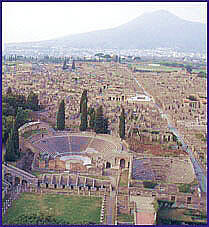 |
From 30 km (18
miles) west of the volcano, Pliny the Younger,
witnessed the eruption and later recorded his
observations in two letters. Volcanologists now
use the term "Plinian" for the first stage of
devastating volcanic eruptions, in which dust,
ashes, cinders, and rocks erupt high into the
air, and in time settle back to Earth. This
stage may last for hours or even days. No lava
flows occur during the plinian stage. In areas
near the eruption, the amount of these materials
can be enormous. During the first eight hours of
the eruption of Vesuvius in 79 AD they fell on
Pompeii to depths of 2 to 4 meters (8-10 ft.). |
The heaps of
small rocks that landed on the houses caused
many roofs to collapse.
In the next stage of the eruption, a superhot
cloud of steam and mud (called "pyroclastic")
flowed down the side of Vesuvius and covered the
towns. At the speed of 30 mt. per second, it
took less than four minutes for the boiling mud
to flow from Vesuvius to Herculaneum, a distance
of about 7 kilometers (4 miles). |
|
About
3 meters (10 ft.) of ash and rocks fell on
Pompeii, burying everything except the roofs of
some buildings. The city was abandoned and its
location forgotten. In 1595, excavations
discovered artifacts at Pompeii and centuries of
pillaging followed. Archeological excavations
began in the mid-nineteenth century. Now, much
of Pompeii has been excavated and it has
revealed much about how people lived during that
time (and died during the eruption).
Herculaneum was
buried under 23 Mt. (75 ft.) of ash. Once a
seaside resort with 5,000 inhabitants, the former
town became inland, and is now surrounded by the
modern city of Ercolano. |
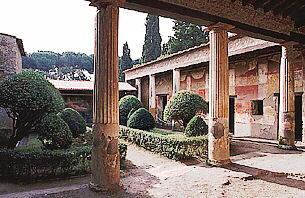 |
|
Silent for
thousands
of years, Pompeii and Herculaneum are now living
museums of life in the Roman Empire during the
first century of the Common Era. The sacrifice
and horrendous sufferings of its inhabitants
resulted in a generous gesture, as they donated
us the means to understand their architecture
and their culture, thus having an insight of the
ancient world otherwise impossible. Thanks to
the sacrifice of the inhabitants, we know their
habits, their customs, even their political
graffiti, or their love messages.
Surprisingly
sophisticated, Pompeii had a grid lay-out (right
photo). It had a three-stream running water
system. One stream went to public fountains,
another to public baths, and a third traveled to
homes of wealthy residents. People in Pompeii
even had a version of indoor plumbing, but they
did not have a good sewer system.
Flowing through
lead pipes from a central water tower (called
the Castellum Aquae), the water delivery system
was ingenious for its day. When water supplies
were low, the town stopped the flow of water
streams in order of priority. First the wealthy
homes were without water, then the public baths.
Public fountains were shut down last. |
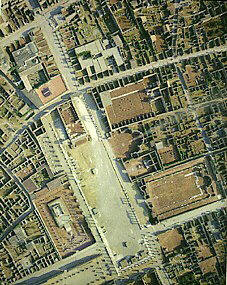 |
|
People in ancient times used mill wheels to
grind flour, and they stored food in large terra-cotta jars. To maintain the food at
constant temperatures, all but the top of a jar was buried in the ground. |
|
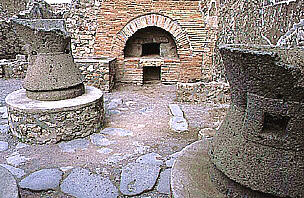 |
Pompeii had
outdoor food bars where its citizens could enjoy a snack and a cool drink. Shops were
clearly marked with carved signs: a goat for the dairy, grapes for the winery,
bread for the bakery. In the baker’s house one could find a fresco of a man selling
bread. |
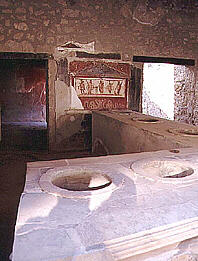 |
|
Pompeii: mills and baker's oven |
Pompeii: a
tavern |
|
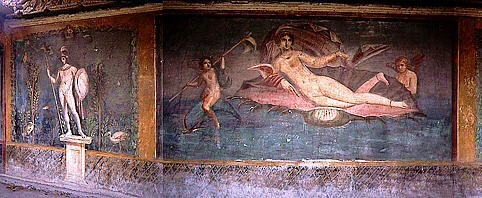 |
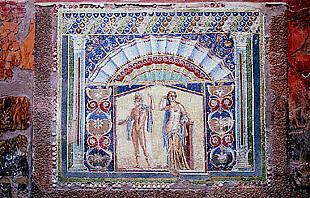 |
|
Pompeii: Villa of Venus:
painting of Venus |
Herculanum: mosaic in villa |
|
A typical upper class residence usually included fresco
wall murals, a fountain, private bath, mosaic floors, an atrium
and inner garden (called a peristyle) and a shrine. |
|
|
In the 1860s, Italian archaeologist Giuseppe
Fiorelli discovered that mounds of ash often contained the moulds of those who perished in
the catastrophe. This method of retrieving the shapes of Vesuvius' victims, now known as
the "Fiorelli Method", has even been extended to recreating the forms of
furniture, doors and shutters on Pompeiian buildings. The casts show the shapes of the
victims in their final moments, trying to filter the noxious fumes of the eruption, and to
breathe, as the terror-filled faces reveal. The mold of a dog is shown in the right. The
poor animal was chained to a post and struggled for hours before finally succumbing to the
ash.
|
|
|
Daily excursions, prices
INDIVIDUAL TRANSPORT TO POMPEII,
You will be
picked up and brought back to the apartment, and the excursion (including the transport)
will last 8 hours.
- for groups up to 3 persons, with a Deluxe Mercedes sedan the price is
550 Euro (app.
740 US$).
- for groups up to 5 persons, with
a small van, it will cost you 580 Euro (app.
783 US$), and the car will
be a Mercedes or Chrysler Van.
- for groups up to 7 persons, with
a large van, it will cost you 720 Euro (app.
970 US$).
The excursions lasts 8
hours, of which four and a half are for transport (two hours and fifteen minutes each
way), and three and a half for the visit itself. If you want the excursion to last more,
it will cost you 40 Euros for every additional hour which you will require (for the
regular sedan, 48 Euro for the small van, and
55 for the large van). The same applies if
you want to visit Herculaneum (Ercolano). If you want to visit *both* towns, as it requires
2-3 additional hours to the Pompeii trip,
which are billed accordingly.
The excursion includes
the transport only, it does not include the entrance tickets (6 Euros or app.
8 US$ per
person), or the meals along the way. If you require a professional tourist guide, you will find them at the
excavations, and their cost is not included. We
recommend that you just buy a good guide book (including a map) at the entrance
of the excavations, and follow its suggestions. In fact, the tourist guides do
not have a transparent price policy.
|
TO
BOOK or to enquire: Please
use our booking form. We will reply to you
swiftly. Upon request we can organize your
transport to any other location or destination.
|
|
|
to Topˆ |
| |
|
|
|
Romecarservice®
is a registered trademark
|
|